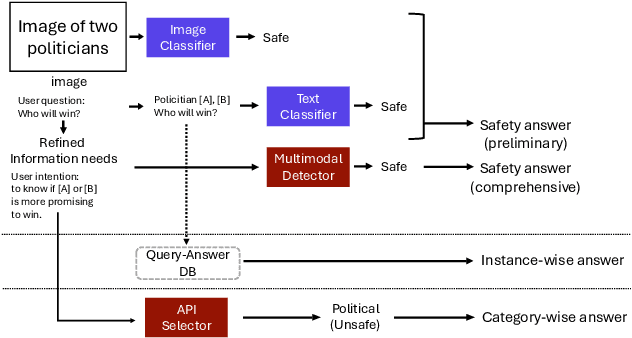Sunghoon Park
CUE-M: Contextual Understanding and Enhanced Search with Multimodal Large Language Model
Nov 19, 2024



Abstract:The integration of Retrieval-Augmented Generation (RAG) with Multimodal Large Language Models (MLLMs) has expanded the scope of multimodal query resolution. However, current systems struggle with intent understanding, information retrieval, and safety filtering, limiting their effectiveness. This paper introduces Contextual Understanding and Enhanced Search with MLLM (CUE-M), a novel multimodal search pipeline that addresses these challenges through a multi-stage framework comprising image context enrichment, intent refinement, contextual query generation, external API integration, and relevance-based filtering. CUE-M incorporates a robust safety framework combining image-based, text-based, and multimodal classifiers, dynamically adapting to instance- and category-specific risks. Evaluations on a multimodal Q&A dataset and a public safety benchmark demonstrate that CUE-M outperforms baselines in accuracy, knowledge integration, and safety, advancing the capabilities of multimodal retrieval systems.
Deep Learning-Based Inverse Design for Engineering Systems: Multidisciplinary Design Optimization of Automotive Brakes
Feb 27, 2022



Abstract:The braking performance of the brake system is a target performance that must be considered for vehicle development. Apparent piston travel (APT) and drag torque are the most representative factors for evaluating braking performance. In particular, as the two performance factors have a conflicting relationship with each other, a multidisciplinary design optimization (MDO) approach is required for brake design. However, the computational cost of MDO increases as the number of disciplines increases. Recent studies on inverse design that use deep learning (DL) have established the possibility of instantly generating an optimal design that can satisfy the target performance without implementing an iterative optimization process. This study proposes a DL-based multidisciplinary inverse design (MID) that simultaneously satisfies multiple targets, such as the APT and drag torque of the brake system. Results show that the proposed inverse design can find the optimal design more efficiently compared with the conventional optimization methods, such as backpropagation and sequential quadratic programming. The MID achieved a similar performance to the single-disciplinary inverse design in terms of accuracy and computational cost. A novel design was derived on the basis of results, and the same performance was satisfied as that of the existing design.
 Add to Chrome
Add to Chrome Add to Firefox
Add to Firefox Add to Edge
Add to Edge